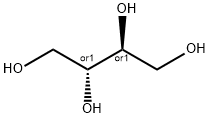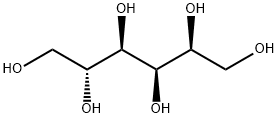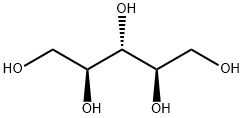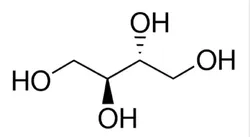Erythritol
Synonym(s):meso-1,2,3,4-Tetrahydroxybutane;meso-Erythritol;1,2,3,4-Butanetetrol;i-Erythritol
- CAS NO.:149-32-6
- Empirical Formula: C4H10O4
- Molecular Weight: 122.12
- MDL number: MFCD00004710
- EINECS: 205-737-3
- SAFETY DATA SHEET (SDS)
- Update Date: 2025-12-26 16:58:18

What is Erythritol?
Description
Erythritol (aka meso-erythritol to distinguish it from other isomers) is a natural sweetener that is also manufactured by fermenting glucose. Even though it contains two chiral centers, it has no optical rotation because the molecule as a whole is symmetrical.
In 1900, Max Bamberger and Anton Landsiedl at the Vienna University of Technology isolated erythritol from the alga1 species Trentepohlia jolithus. Other researchers soon found it in organisms as disperse as lichens and grasses. But much earlier than these findings, eminent chemist August Wilhelm von Hofmann at the University of Berlin reported its synthesis in an 1874 article titled “Synthesis of the ethereal oil of Cochlearia officinalis” (a flowering plant in the family Brassicaceae).
Erythritol is about two-thirds as sweet as sucrose, but it is not caloric and does not contribute to tooth decay or blood sugar. Since the 1990s, it has been marketed as a low-calorie sweetener, often in combination with monkfruit (Siraita grosvenorii) extracts (mainly the glycoside mogroside V2) and D-tagatose3, a sugar derivative obtained from galactose4.
Despite its widespread use, erythritol has its downsides. In 2022, the northern California Meritage Medical Network published an article citing its side effects and dangers. It stated:
Erythritol side effects typically include digestive problems and diarrhea. It may also cause bloating, cramps, and gas. Additionally, erythritol and other sugar alcohols frequently result in more water in the intestines, causing diarrhea. Nausea and headaches may occur as well.
A report last month from the National Institutes of Health was even more foreboding. The results of an NIH study suggested that
consuming erythritol can increase blood clot formation. This, in turn, could increase the risk of heart attack or stroke. Given the prevalence of erythritol in artificially sweetened foods, further safety studies of the health risks of erythritol are warranted.
As with other sweeteners such as saccharin and aspartame, zero calories may come at a price. For more on erythritol see the ScienceDirect information page.
1. Next week’s MOTW will feature more algae-derived molecules as Chemists Celebrate Earth Week with “The Curious Chemistry of Amazing Algae”.
2. CAS Reg. No. 88901-36-4.
3. CAS Reg. No. 87-81-0.
4. CAS Reg. No. 59-23-4.
Chemical properties
white crystals or powder
Chemical properties
Erythritol (meso-erythritol, meso-1,2,3,4-Tetrahydroxybutan) has been
known for a long time. Its potential use as a bulk sweetener was, however, recognized
rather late.
Erythritol is a natural constituent of several foods and beverages in levels
sometimes exceeding 1 g/kg. Its solubility in water is approximately 370 g/L at
room temperature and increases with increasing temperature. Erythritol melts at
121 C and is stable up to more than 160 C and in a pH range from 2 to 10.
Depending on the concentration used, erythritol is approximately 60 % as sweet
as sucrose. It is noncariogenic and not metabolized in the human body which
means that it is more or less calorie-free.
In the European Union, erythritol is approved as E 968 for a large number of
food applications. It is GRAS in the United States and also approved
in many other countries.
Chemical properties
Erythritol is a sugar alcohol (polyol) that occurs as a white or almost white powder or granular or crystalline substance. It is pleasant tasting with a mild sweetness approximately 60–70% that of sucrose. It also has a high negative heat of solution that provides a strong cooling effect.
Characteristics
The sweetness of erythritol is low, the sweetness of erythritol is only 60%-70% of sucrose, the entrance has a cool taste, the taste is pure, and there is no post-bitterness. It can be used in combination with high-intensity sweeteners to inhibit its Undesirable flavors of high-intensity sweeteners. Erythritol has high stability, is very stable to acid and heat, and has high acid and alkali resistance. It will not decompose and change at temperatures below 200 °C, and will not undergo Maillard reaction to cause discoloration. The heat of dissolution of erythritol is high: erythritol has an endothermic effect when dissolved in water, and the heat of dissolution is only 97.4kJ/kg, which is higher than the endothermic degree of glucose and sorbitol, and has a cooling feeling when eating. The solubility of erythritol at 25 °C is 37% (W/W). With the increase of temperature, the solubility of erythritol increases, and it is easy to crystallize and separate out crystals. Erythritol is very easy to crystallize, but it will not absorb moisture in a 90% humidity environment. It is easy to be crushed to obtain a powdery product, which can be used on the surface of food to prevent food from absorbing moisture and deteriorating.
The Uses of Erythritol
Erythritol is a sweetener (polyol) manufactured by fermentation of glucose, the glucose-rich substrate being obtained by the enzymatic hydrolysis of starch. it is 60–70% as sweet as sugar, has excellent heat and acid stability, a high digestive tolerance, and a caloric value of 0.2 kcal/g. it is the only polyol produced by fermentation. it can be used as a sugar replacement in confectioneries, beverages, and desserts.
The Uses of Erythritol
non-cariogenic, low-calorie (0.4 kcal/g) sweetener
The Uses of Erythritol
Non-nutritive sweetener in beverages.
What are the applications of Application
meso-Erythritol is a potential T1R3 receptor ligand
Definition
ChEBI: The meso-diastereomer of butane-1,2,3,4-tetrol.
Production Methods
Erythritol is a starch-derived product. The starch is enzymatically hydrolyzed into glucose which is turned into erythritol via a fermentation process, using osmophilic yeasts or fungi (e.g. Moniliella pollinis, or Trichosporonoides megachiliensis).
Biotechnological Production
The synthesis of erythritol is rather difficult. One of the possibilities is the catalytic
reduction of tartaric acid with Raney nickel, which does, however, also produce
threitol, a diastereomere of erythritol that requires separation of both. Threitol may
be isomerized which increases the yields of erythritol. Another chemical synthesis
starts from butane-2-diol-1.4 which is reacted with chlorine in aqueous alkali to
yield erythritol-2-chlorohydrin and can be hydrolyzed with sodium carbonate solution. Synthesis from dialdehyde starch in the presence of a nickel catalyst at
high temperatures is also possible.
Owing to the special physiological properties of erythritol, commercial interest
increased with the discovery of an increasing number of microorganisms able to
produce this substance. Today, the commercial production of erythritol is apparently
only based on fermentation.
Erythrytitol fermentations mostly use osmophilic yeasts. Based on regulatory
submissions for commercial production, T. megachiliensis, M. pollinis, and
Y. lipolytica are used. It is also claimed that P. tsukubaensis and Aureobasidium
sp. are used for commercial production.
Erythritol-producing microorganisms often produce other polyols such as
ribitol. Nevertheless, some strains had a rather high yield of erythritol. A two-step
fermentation of C. magnoliae on 400 g/L glucose resulted in a 41 % conversion
rate and a productivity of 2.8 g/Lh. M. pollinis cultivated on glucose and
several nitrogen sources yielded erythritol concentrations up to 175 g/L with a
conversion rate of 43 %. Oxygen limitation resulted in ethanol formation, and
nitrogen limitation in strong foaming. A mutant gave even better yields.
Aerobically on glucose cultured P. tsukubaensis KN 75 produced 245 g/L of
erythritol with an especially high yield of 61 %. The productivity was 2.86 g/Lh.
Scale-up from 7-L laboratory fermenter to 50,000-L industrial scale resulted in
productivities similar to the laboratory value.
General Description
meso-Erythritol, belonging to the class of sugar alcohols, is identified in a variety of food products, fruits, vegetables, beverages and dietary supplements. It is known as a low glycemic food additive and plays an important role as a sweetener for diabetic patients, since it does not have glycemic or insulinemic effect due to its ability to not get metabolized but get absorbed in the small intestine. It is also reportedly used as a sugar substitute in toothpaste, chewing gums, confectionery food products, etc.
Flammability and Explosibility
Not classified
Pharmaceutical Applications
Erythritol is a naturally occurring noncariogenic excipient used in a
variety of pharmaceutical preparations, including in solid dosage
forms as a tablet filler, and in coatings. It has also been
investigated for use in dry powder inhalers.It is also used in
sugar-free lozenges,and medicated chewing gum.
Erythritol can also be used as a diluent in wet granulation in
combination with moisture-sensitive drugs. In buccal applications,
such as medicated chewing gums, it is used because of its high
negative heat of solution which provides a strong cooling effect.
Erythritol is also used as a noncaloric sweetener in syrups; it is
used to provide sensorial profile-modifying properties with intense
sweeteners; and it is also used to mask unwanted aftertastes.
Erythritol is also used as a noncariogenic sweetener in toothpastes
and mouthwash solutions.
Biochem/physiol Actions
Allelic variation of the Tas1r3 gene affects behavioral taste responses to this sugar alcohol, suggesting that it is a T1R3 receptor ligand.
Safety
Erythritol is used in oral pharmaceutical formulations, confectionery,
and food products. It is generally regarded as a nontoxic,
nonallergenic, and nonirritant material. However, there has been
a case report of urticaria caused by erythritol.
The low molecular weight of erythritol allows more than 90% of
the ingested molecules to be rapidly absorbed from the small
intestine; it is not metabolized and is excreted unchanged in the
urine. Erythritol has a low caloric value (0.8 kJ/g). The WHO has
set an acceptable daily intake of ‘not specified’ for erythritol.
Erythritol is noncariogenic; preliminary studies suggest that it
may inhibit the formation of dental plaque.
In general, erythritol is well-tolerated; furthermore,
excessive consumption does not cause laxative effects. There is no
significant increase in the blood glucose level after oral intake, and
glycemic response is very low, making erythritol suitable for
diabetics.
LD50 (mouse, IP): 8–9 g/kg
LD50 (rat, IV): 6.6 g/kg
LD50 (rat, oral): >13 g/kg
Storage
Erythritol has very good thermal and chemical stability. It is nonhygroscopic, and at 25°C does not significantly absorb additional water up to a relative humidity (RH) of more than 80%. Erythritol resists decomposition both in acidic and alkaline media and remains stable for prolonged periods at pH 2–10.(10) When stored for up to 4 years in ambient conditions (20°C, 50% RH) erythritol has been shown to be stable.
Purification Methods
meso-Erythritol crystallises from distilled water or absolute EtOH and is dried at 60o in a vacuum oven. It sublimes at 110o in a high vacuum. It is optically inactive. [Jeans & Hudson J Org Chem 20 1565 1955, IR: Kuhn Anal Chem 22 276 1950, Beilstein 1 IV 2807.]
Incompatibilities
Erythritol is incompatible with strong oxidizing agents and strong bases.
Regulatory Status
GRAS listed. Accepted for use as a food additive in Europe.
Properties of Erythritol
| Melting point: | 118-120 °C (lit.) |
| Boiling point: | 329-331 °C (lit.) |
| Density | 1,451 g/cm3 |
| refractive index | 1.4502 (estimate) |
| FEMA | 4819 | ?ERYTHRITOL |
| Flash point: | 329-331°C |
| storage temp. | -20°C |
| solubility | H2O: 0.1 g/mL, clear to almost clear, colorless |
| appearance | white crystals or powder |
| form | Crystalline Powder or Crystals |
| pka | 13.9(at 25℃) |
| color | White to off-white |
| Odor | at 100.00?%. odorless |
| Water Solubility | soluble |
| Merck | 14,3675 |
| BRN | 1719753 |
| Stability: | Stable. Incompatible with strong oxidizing agents. |
| CAS DataBase Reference | 149-32-6(CAS DataBase Reference) |
| NIST Chemistry Reference | 2(r),3(s)-1,2,3,4-Butanetetrol(149-32-6) |
| EPA Substance Registry System | Erythrol (149-32-6) |
Safety information for Erythritol
| Signal word | Warning |
| Pictogram(s) |
 Exclamation Mark Irritant GHS07 |
| GHS Hazard Statements |
H315:Skin corrosion/irritation H319:Serious eye damage/eye irritation H335:Specific target organ toxicity, single exposure;Respiratory tract irritation |
| Precautionary Statement Codes |
P261:Avoid breathing dust/fume/gas/mist/vapours/spray. P305+P351+P338:IF IN EYES: Rinse cautiously with water for several minutes. Remove contact lenses, if present and easy to do. Continuerinsing. |
Computed Descriptors for Erythritol
| InChIKey | UNXHWFMMPAWVPI-ZXZARUISSA-N |
Erythritol manufacturer
New Products
4,4-Difluoropiperidine hydrochloride tert-butyl 9-methoxy-3-azaspiro[5.5]undecane-3-carboxylate Indole Methyl Resin N-Isopropylurea N,N-Dicyclohexylcarbodiimide(DCC) MELDRUMS ACID 5-METHYLISOXAZOLE-4-CARBOXYLIC ACID Magnessium Bis glycinate Zinc ascorbate 1-bromo-2-butyne 2-acetamidophenol 9(10H)-anthracenone Erythrosin B, 4-Piperidinopiperidine 2-((4-morpholinophenylamino) (methylthio) methylene) malononitrile 2,4-dihydroxybenzaldehyde 3-(4-morpholinophenylamino)-5-amino-1H-pyrazole-4-carbonitrile Methyl 2-methylquinoline-6-carboxylate 2,6-dichloro-4-nitropyridine 4-Bromo-2-chlorobenzonitrile 2-(benzylamino)acetic acid hydrochloride 4-(tert-Butoxycarbonylamino)but- 2-ynoic acid 3,4-dihydro-2H-benzo[b][1,4]dioxepine 1-Phenyl-1-cycloprppanecarboxylicacidRelated products of tetrahydrofuran








You may like
-
 149-32-6 Erythritol 99%View Details
149-32-6 Erythritol 99%View Details
149-32-6 -
 Erythritol CAS 149-32-6View Details
Erythritol CAS 149-32-6View Details
149-32-6 -
 Erythritol extrapure CAS 149-32-6View Details
Erythritol extrapure CAS 149-32-6View Details
149-32-6 -
 meso-Erythritol CAS 149-32-6View Details
meso-Erythritol CAS 149-32-6View Details
149-32-6 -
 Erythritol CAS 149-32-6View Details
Erythritol CAS 149-32-6View Details
149-32-6 -
 meso-Erythritol 99% CAS 149-32-6View Details
meso-Erythritol 99% CAS 149-32-6View Details
149-32-6 -
 Sweetener Name: Erythritol Industrial Grade Polyol Isocyanate, Liquid, Purity: 99%View Details
Sweetener Name: Erythritol Industrial Grade Polyol Isocyanate, Liquid, Purity: 99%View Details
149-32-6 -
 Erythritol (CAS Number: 149-32-6)View Details
Erythritol (CAS Number: 149-32-6)View Details
149-32-6
